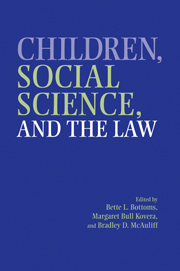Book contents
- Frontmatter
- Contents
- Acknowledgments
- Contributors
- 1 Children, Social Science, and the Law: An Introduction to the Issues
- PART I CHILDREN'S RIGHTS, THEIR CAPABILITIES, AND SOCIETY'S RESPONSIBILITIES TO CHILDREN
- 2 The Personal Responsibility and Work Opportunity Reconciliation Act of 1996: What Will It Mean for Children?
- 3 Advocacy for Children's Rights
- 4 Children's Rights and Capacities
- 5 Children's Legal Representation in Civil Litigation
- PART II CHILDREN AND FAMILY CHANGE
- PART III JUVENILE AGGRESSION AND JUVENILE JUSTICE
- PART IV CHILDREN AS VICTIMS AND WITNESSES
- PART V CONCLUSIONS AND FUTURE DIRECTIONS
- Author Index
- Case Index
- Subject Index
- References
3 - Advocacy for Children's Rights
Published online by Cambridge University Press: 24 July 2009
- Frontmatter
- Contents
- Acknowledgments
- Contributors
- 1 Children, Social Science, and the Law: An Introduction to the Issues
- PART I CHILDREN'S RIGHTS, THEIR CAPABILITIES, AND SOCIETY'S RESPONSIBILITIES TO CHILDREN
- 2 The Personal Responsibility and Work Opportunity Reconciliation Act of 1996: What Will It Mean for Children?
- 3 Advocacy for Children's Rights
- 4 Children's Rights and Capacities
- 5 Children's Legal Representation in Civil Litigation
- PART II CHILDREN AND FAMILY CHANGE
- PART III JUVENILE AGGRESSION AND JUVENILE JUSTICE
- PART IV CHILDREN AS VICTIMS AND WITNESSES
- PART V CONCLUSIONS AND FUTURE DIRECTIONS
- Author Index
- Case Index
- Subject Index
- References
Summary
Advocacy on behalf of children is more than simply the provision of needed services to children. Advocacy efforts represent an attempt to increase the responsiveness and accountability of all institutions affecting children. As Melton (1983) notes, “whether the intent is to increase children's self-determination or to enhance the social, education, and medical resources to which children are entitled, child advocates have as their mission social action on behalf of children” (p. 1).
Although social scientists often conduct and report research related to child well-being, these efforts frequently fail to take into account larger social trends affecting children and families. Moreover, they often fall short of informing advocacy efforts – either in helping to set an agenda for advocacy or in evaluating advocacy efforts. The intent of this chapter is to provide an overview of child advocacy issues for social scientists in order to facilitate a greater connection between social scientists and child advocates. We begin by noting some significant social trends influencing the nature of child advocacy. These include the changing nature of the American family, the changing nature of social institutions, and the shift in responsibility for children's welfare from the federal government to state and community organizations. Next, a brief history of advocacy is presented, noting philosophical differences between those who push for increasing self-determination of children and those who primarily advocate for improved health and safety conditions for children.
- Type
- Chapter
- Information
- Children, Social Science, and the Law , pp. 51 - 75Publisher: Cambridge University PressPrint publication year: 2002
References
- 2
- Cited by

